-
WANTED: Happy members who like to discuss audio and other topics related to our interest. Desire to learn and share knowledge of science required. There are many reviews of audio hardware and expert members to help answer your questions. Click here to have your audio equipment measured for free!
You are using an out of date browser. It may not display this or other websites correctly.
You should upgrade or use an alternative browser.
You should upgrade or use an alternative browser.
Wharfedale Linton Heritage with Audiophonics HPA-S250NC first REW meauserements
- Thread starter PeterNL
- Start date
PeterNL
Member
- Thread Starter
- #22
I am back again 
Today I did new Dirac correction. Speakers against front wall (it seems to be the best position, I have tried many). Sounds good for me but FR still looks bad in 130-300Hz region. Mdat file is attached. Comments, tips and tricks or deeper interpretation (waterfall, IR, phase, decay....) are very welcome.



Today I did new Dirac correction. Speakers against front wall (it seems to be the best position, I have tried many). Sounds good for me but FR still looks bad in 130-300Hz region. Mdat file is attached. Comments, tips and tricks or deeper interpretation (waterfall, IR, phase, decay....) are very welcome.
Attachments
PeterNL
Member
- Thread Starter
- #24
Yesterday I have ordered 2 bass trap panels:
- GIK acoustics 244
- GIK Monster Bass trap
They will arrive probably next week, so I still have time to figure out where to put them and find early reflection points and spots which causes deep valley and nulls.
Unfortunately my living room is a L shape so it it difficult for me to calculate room modes.
Whi REW measurements should I do, to easily find reflection points and put absorbers in right places ?
I am going to use mirror method too.
If it will be needed I would be able to buy few absorbers or difusser more in the future.
I hope it will be enough to eliminate 130-300Hz dips.
- GIK acoustics 244
- GIK Monster Bass trap
They will arrive probably next week, so I still have time to figure out where to put them and find early reflection points and spots which causes deep valley and nulls.
Unfortunately my living room is a L shape so it it difficult for me to calculate room modes.
I will also try to find bigger and thicker rug instead of one which I already have.Try with larger thicker rug.
Whi REW measurements should I do, to easily find reflection points and put absorbers in right places ?
I am going to use mirror method too.
If it will be needed I would be able to buy few absorbers or difusser more in the future.
I hope it will be enough to eliminate 130-300Hz dips.
Try with larger thicker rug.
A thick rug will be good for taming the high-frequency energy, but will not do much for the problematic area of 150 Hz to 600 Hz Peter wants to solve.
@PeterNL, you should try different locations for the absorbers when they arrive, and take measurements to see where they make the most for that valley, the first placement I would have tried is on the wall behind the speakers at the first reflection point. Use a mirror to locate the reflection point inside the speakers and place the GIK acoustics 244 at that position. If there is room for it, you can leave an air gap between the wall and the absorbers to make them even more effective for lower frequencies.
ZolaIII
Major Contributor
- Joined
- Jul 28, 2019
- Messages
- 4,195
- Likes
- 2,475
It's either floor or celling but I can't really recommend him to put something on celling can I? It's close to wall behind with last measurements which are by far best so far. I can recommend pluging the port's, crossing them high (100~120 Hz) each per it's own sub which would improve over all situation with refractions but that is if he already has all what he needs. In the meantime balancing the distance between celling and floor and improving absorbing under would help. For me thick rug all the way from corner of corner did the job with even lower deep but then again my celling is better than most (as it's wood decking).A thick rug will be good for taming the high-frequency energy, but will not do much for the problematic area of 150 Hz to 600 Hz Peter wants to solve.
@PeterNL, you should try different locations for the absorbers when they arrive, and take measurements to see where they make the most for that valley, the first placement I would have tried is on the wall behind the speakers at the first reflection point. Use a mirror to locate the reflection point inside the speakers and place the GIK acoustics 244 at that position. If there is room for it, you can leave an air gap between the wall and the absorbers to make them even more effective for lower frequencies.
Just for example and from totally different speakers:
As you see impact on highs ain't as described.
Absorber panel behind won't have the effect with speakers pushed close to it and won't have desired effect in lows anyway (for that you need 30 cm thick cage).
ernestcarl
Major Contributor
I am back again
Today I did new Dirac correction. Speakers against front wall (it seems to be the best position, I have tried many). Sounds good for me but FR still looks bad in 130-300Hz region. Mdat file is attached. Comments, tips and tricks or deeper interpretation (waterfall, IR, phase, decay....) are very welcome.
Magnitude response above 500 Hz holds some semblance to independent sources.
Wharfedale Linton 85th Anniversary Speaker Review
Wharfedale Linton 85th Anniversary Review
www.erinsaudiocorner.com

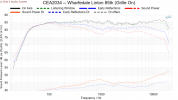
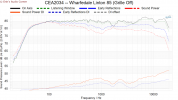
Pronounced hump between 6-10 kHz is probably from floor reflection and/or could be due to absence of the grill when measuring.
I don't believe 500 Hz and up absolutely needs to DRC'd or EQ'd -- unless it is something you want to apply more as a general tonal control (broad EQ) to fit your personal preference.
Below 100 Hz belongs in the modal region and those peaky room resonances will really need EQ. You mentioned the couch MLP is right against the wall which is where low frequency pressure would also be at its maximum... and so the FR curves do seem to reflect that fact.
Between ~100 and 500 Hz there is a mix of higher density modes and boundary interferences (transition zone). Some of this can be compensated for with EQ; yes, it could potentially make sound worse elsewhere in the room, say, if EQ boosting too much causing audible distortion at higher playback levels. Here, distortion is interesting to look/listen for post Dirac EQ at higher test playback levels. Try playing band limited burst test tones at places where high gain narrow band EQ peak filter(s) are enabled.
Won't comment much on the RT60 in small rooms since it's really not all that useful, IMO, in small rooms like this. However, it looks typical for an untreated domestic room.
Absorber panel behind won't have the effect with speakers pushed close to it and won't have desired effect in lows anyway (for that you need 30 cm thick cage).
Hmmmn... I don't agree that absorption in this wall side produces undesirable effects or has no benefit at all.
From F. Toole's book:
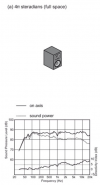
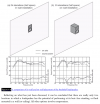
Now, if you have to push speakers as close as possible to the wall, thinner yet denser panels may work better (e.g. Rockwool/Rockboard 40/60 or even 80 if the former is hard to come by since the latter is readily available at Home Depot etc). Note, however, that no more than four inches of this much denser absorber material should be used.
--------------
Other interesting plot views of your last two mdat files follow.
25 dB/dec Aspect Ratio:
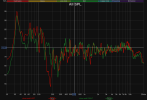
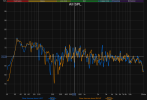
Full vs early and late Frequency response:
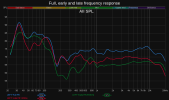

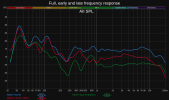
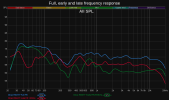
Evidently, much of the volume what you're hearing is the "room", but at least it's mostly flattish. Late FR is also overlapping or is louder than the initial response -- which is not so good -- mostly below 500 Hz.
Other examples for comparison here: https://www.audiosciencereview.com/forum/index.php?threads/a-b-room-treatments.47093/post-1684619
Log IR - ETC:

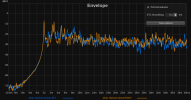

There are some strong very early reflections (up to 10 ms). You might want to take care of that with acoustic treatment -- if domestically acceptable.
Wavelet spectrogram:
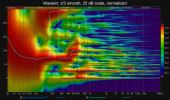

Stuff below 500 or 600 Hz is quite a bit lumpy and smeared or quite uneven, consequently the transient behavior around and below the transition zone is not particularly great.
Spectral Decay (Late Frequency Response):
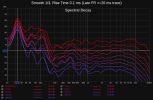
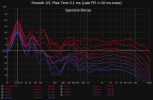
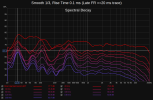
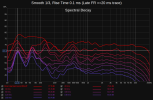
Last edited:
PeterNL
Member
- Thread Starter
- #29
I will try different positions adding first only one panel and then 2. My room is L shaped so only left speakers is placed close to the corner so I will try different panels there or both of them.A thick rug will be good for taming the high-frequency energy, but will not do much for the problematic area of 150 Hz to 600 Hz Peter wants to solve.
@PeterNL, you should try different locations for the absorbers when they arrive, and take measurements to see where they make the most for that valley, the first placement I would have tried is on the wall behind the speakers at the first reflection point. Use a mirror to locate the reflection point inside the speakers and place the GIK acoustics 244 at that position. If there is room for it, you can leave an air gap between the wall and the absorbers to make them even more effective for lower frequencies.
PeterNL
Member
- Thread Starter
- #30
I am going to try every possible combination, will check all first reflection points and put absorbers there, also on the floor. Already have 2 rugs in this room, pretty heavy and high. Do not have subwoofers and not going to buy in close future.It's either floor or celling but I can't really recommend him to put something on celling can I? It's close to wall behind with last measurements which are by far best so far. I can recommend pluging the port's, crossing them high (100~120 Hz) each per it's own sub which would improve over all situation with refractions but that is if he already has all what he needs. In the meantime balancing the distance between celling and floor and improving absorbing under would help. For me thick rug all the way from corner of corner did the job with even lower deep but then again my celling is better than most (as it's wood decking).
Just for example and from totally different speakers:
As you see impact on highs ain't as described.
Absorber panel behind won't have the effect with speakers pushed close to it and won't have desired effect in lows anyway (for that you need 30 cm thick cage).
ZolaIII
Major Contributor
- Joined
- Jul 28, 2019
- Messages
- 4,195
- Likes
- 2,475
@ernestcarl didn't say it will have undesirable effect but it won't have effect when speakers are pushed to it or a very little effect and certainly won't be in desired range even if they are not with classic 4~5" rock wool panels. And regarding 30 cm cages read this:
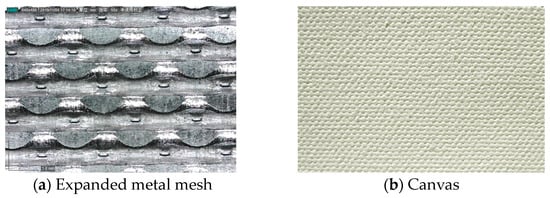
 www.mdpi.com
www.mdpi.com

Development of a Panel Membrane Resonant Absorber
The bass ratio describes the relationship between the reverberation energy in the low frequency region and that of the middle frequency. An appropriate bass ratio can create a warm sound; however, too much bass can influence speech clarity (C50) and work efficiency and can even cause listeners...
PeterNL
Member
- Thread Starter
- #32
Thank you for your effort and time to analyze my mdat files. It will take some time for me to understand it, but I will learn.Magnitude response above 500 Hz holds some semblance to independent sources.
Wharfedale Linton 85th Anniversary Speaker Review
Wharfedale Linton 85th Anniversary Reviewwww.erinsaudiocorner.com
View attachment 309838 View attachment 309839 View attachment 309840
Pronounced hump between 6-10 kHz is probably from floor reflection and/or could be due to absence of the grill when measuring.
I don't believe 500 Hz and up absolutely needs to DRC'd or EQ'd -- unless it is something you want to apply more as a general tonal control (broad EQ) to fit your personal preference.
Below 100 Hz belongs in the modal region and those peaky room resonances will really need EQ. You mentioned the couch MLP is right against the wall which is where low frequency pressure would also be at its maximum... and so the FR curves do seem to reflect that fact.
Between ~100 and 500 Hz there is a mix of higher density modes and boundary interferences (transition zone). Some of this can be compensated for with EQ; yes, it could potentially make sound worse elsewhere in the room, say, if EQ boosting too much causing audible distortion at higher playback levels. Here, distortion is interesting to look/listen for post Dirac EQ at higher test playback levels. Try playing band limited burst test tones at places where high gain narrow band EQ peak filter(s) are enabled.
Won't comment much on the RT60 in small rooms since it's really not all that useful, IMO, in small rooms like this. However, it looks typical for an untreated domestic room.
Hmmmn... I don't agree that absorption in this wall side produces undesirable effects or has no benefit at all.
From F. Toole's book:
View attachment 309841 View attachment 309842
Now, if you have to push speakers as close as possible to the wall, thinner yet denser panels may work better (e.g. Rockwool/Rockboard 40/60 or even 80 if the former is hard to come by since the latter is readily available at Home Depot etc). Note, however, that no more than four inches of this much denser absorber material should be used.
--------------
Other interesting plot views of your last two mdat files follow.
25 dB/dec Aspect Ratio:
View attachment 309843 View attachment 309845
Full vs early and late Frequency response:
View attachment 309846 View attachment 309847 View attachment 309848 View attachment 309849
Evidently, much of the volume what you're hearing is the "room", but at least it's mostly flattish. Late FR is also overlapping or is louder than the initial response -- which is not so good -- mostly below 500 Hz.
Other examples for comparison here: https://www.audiosciencereview.com/forum/index.php?threads/a-b-room-treatments.47093/post-1684619
Log IR - ETC:
View attachment 309850 View attachment 309851View attachment 309852
There are some strong very early reflections (up to 10 ms). You might want to take care of that with acoustic treatment -- if domestically acceptable.
Wavelet spectrogram:
View attachment 309855 View attachment 309856
Stuff below 500 or 600 Hz is quite a bit lumpy and smeared or quite uneven, consequently the transient behavior around and below the transition zone is not particularly great.
Spectral Decay (Late Frequency Response):
View attachment 309857 View attachment 309858 View attachment 309859View attachment 309860
I will find out what is causing strong early reflections, will move some things around, put GIK panels to different positions, next to the speakers, left corner, above and next or behind right speaker.
Left speaker closest boundaries (measured from the center of bass driver):
* 36cm from front wall
* 51cm from left wall
* 58cm from the floor
* 20cm from the top surface of TV cabinet
*110cm from garden door (70% double glas)
*186cm from the ceiling
Right speaker front wall, floor, ceiling 100% the same.
*90cm to the table,
*80cm chair
Next to the speakers is air cleaner and fan (these things standing there temporary, can be moved.
Between both speakers TV 60", standing 21cm from the front wall and 50cm from cone of bass driver.
ernestcarl
Major Contributor
@ernestcarl didn't say it will have undesirable effect but it won't have effect when speakers are pushed to it or a very little effect and certainly won't be in desired range even if they are not with classic 4~5" rock wool panels. And regarding 30 cm cages read this:

Development of a Panel Membrane Resonant Absorber
The bass ratio describes the relationship between the reverberation energy in the low frequency region and that of the middle frequency. An appropriate bass ratio can create a warm sound; however, too much bass can influence speech clarity (C50) and work efficiency and can even cause listeners...www.mdpi.com
Yes, I expect only a very small effect, but it will be positive in improving the time performance and clarity below 500 Hz. The cost for this simple experiment is only about $80.00 if raw materials were only used as a simple trial experiment.
ernestcarl
Major Contributor
Thank you for your effort and time to analyze my mdat files. It will take some time for me to understand it, but I will learn.
I will find out what is causing strong early reflections, will move some things around, put GIK panels to different positions, next to the speakers, left corner, above and next or behind right speaker.
Left speaker closest boundaries (measured from the center of bass driver):
* 36cm from front wall
* 51cm from left wall
* 58cm from the floor
* 20cm from the top surface of TV cabinet
*110cm from garden door (70% double glas)
*186cm from the ceiling
Right speaker front wall, floor, ceiling 100% the same.
*90cm to the table,
*80cm chair
Next to the speakers is air cleaner and fan (these things standing there temporary, can be moved.
Between both speakers TV 60", standing 21cm from the front wall and 50cm from cone of bass driver.
The ETC and spectrograms are the plots that would help you see objectively if the panels are in the right place.
Truth is, I don’t even bother acoustically treating my own main living room… but EQ is still very beneficial nevertheless. It takes too much physical treatment material and effort to treat low frequencies sufficiently to even make a significant dent in the LF magnitude response graphs.
It's either floor or celling but I can't really recommend him to put something on celling can I? It's close to wall behind with last measurements which are by far best so far. I can recommend pluging the port's, crossing them high (100~120 Hz) each per it's own sub which would improve over all situation with refractions but that is if he already has all what he needs. In the meantime balancing the distance between celling and floor and improving absorbing under would help. For me thick rug all the way from corner of corner did the job with even lower deep but then again my celling is better than most (as it's wood decking).
Just for example and from totally different speakers:
As you see impact on highs ain't as described.
Absorber panel behind won't have the effect with speakers pushed close to it and won't have desired effect in lows anyway (for that you need 30 cm thick cage).
I like my large thick rya carpet (2.5 x 3.5 meters) and the way it tames the high frequency of the spectrum, but it sure doesn't do much for the frequency area Peter tries to solve, the area from 150 to 600 Hz.
Watch the video below where Jesco from Acoustic Insider goes through the coefficient of typical carpets, both thin and thick.
If the tool Jesco uses in that video to calculate the frequency of the first floor-cancellation is trustworthy, the fairly long listening distance of 4,10-4,50 meters Peter has means that the first floor-cancellation occurs somewhere between 650 Hz and 750 Hz, but that frequency area doesn't seem to be highly problematic in Peters situation.
The calculation tool: https://mehlau.net/audio/floorbounce/
Last edited:
PeterNL
Member
- Thread Starter
- #37
Magnitude response above 500 Hz holds some semblance to independent sources.
Wharfedale Linton 85th Anniversary Speaker Review
Wharfedale Linton 85th Anniversary Reviewwww.erinsaudiocorner.com
View attachment 309838 View attachment 309839 View attachment 309840
Pronounced hump between 6-10 kHz is probably from floor reflection and/or could be due to absence of the grill when measuring.
I don't believe 500 Hz and up absolutely needs to DRC'd or EQ'd -- unless it is something you want to apply more as a general tonal control (broad EQ) to fit your personal preference.
Below 100 Hz belongs in the modal region and those peaky room resonances will really need EQ. You mentioned the couch MLP is right against the wall which is where low frequency pressure would also be at its maximum... and so the FR curves do seem to reflect that fact.
Between ~100 and 500 Hz there is a mix of higher density modes and boundary interferences (transition zone). Some of this can be compensated for with EQ; yes, it could potentially make sound worse elsewhere in the room, say, if EQ boosting too much causing audible distortion at higher playback levels. Here, distortion is interesting to look/listen for post Dirac EQ at higher test playback levels. Try playing band limited burst test tones at places where high gain narrow band EQ peak filter(s) are enabled.
Won't comment much on the RT60 in small rooms since it's really not all that useful, IMO, in small rooms like this. However, it looks typical for an untreated domestic room.
Hmmmn... I don't agree that absorption in this wall side produces undesirable effects or has no benefit at all.
From F. Toole's book:
View attachment 309841 View attachment 309842
Now, if you have to push speakers as close as possible to the wall, thinner yet denser panels may work better (e.g. Rockwool/Rockboard 40/60 or even 80 if the former is hard to come by since the latter is readily available at Home Depot etc). Note, however, that no more than four inches of this much denser absorber material should be used.
--------------
Other interesting plot views of your last two mdat files follow.
25 dB/dec Aspect Ratio:
View attachment 309843 View attachment 309845
Full vs early and late Frequency response:
View attachment 309846 View attachment 309847 View attachment 309848 View attachment 309849
Evidently, much of the volume what you're hearing is the "room", but at least it's mostly flattish. Late FR is also overlapping or is louder than the initial response -- which is not so good -- mostly below 500 Hz.
Other examples for comparison here: https://www.audiosciencereview.com/forum/index.php?threads/a-b-room-treatments.47093/post-1684619
Log IR - ETC:
View attachment 309850 View attachment 309851View attachment 309852
There are some strong very early reflections (up to 10 ms). You might want to take care of that with acoustic treatment -- if domestically acceptable.
Wavelet spectrogram:
View attachment 309855 View attachment 309856
Stuff below 500 or 600 Hz is quite a bit lumpy and smeared or quite uneven, consequently the transient behavior around and below the transition zone is not particularly great.
Spectral Decay (Late Frequency Response):
View attachment 309857 View attachment 309858 View attachment 309859View attachment 309860
Do You think that I can use this method to find "obstacles" which is causing boost or nulls like in this thread ?:

REW-Analyzing the ETC - Gearspace.com
I am starting a new thread here because I feel the Energy Time Curve has a significant amount if information that can be used to understand what our ro
gearspace.com
PeterNL
Member
- Thread Starter
- #38
Do You think that I can use this method to find "obstacles" which is causing boost or nulls like in this thread ?:

REW-Analyzing the ETC - Gearspace.com
I am starting a new thread here because I feel the Energy Time Curve has a significant amount if information that can be used to understand what our rogearspace.com

A/B Room Treatments
What's the best way to A/B test acoustic treatments? It's so difficult to listen to them even close to back to back. Would getting a binaural mic and recording songs playing work. It would still be subjective but perhaps would provide some value? I think REW would help but I'm not sure how...
 www.audiosciencereview.com
www.audiosciencereview.com
ernestcarl
Major Contributor
Do You think that I can use this method to find "obstacles" which is causing boost or nulls like in this thread ?:

REW-Analyzing the ETC - Gearspace.com
I am starting a new thread here because I feel the Energy Time Curve has a significant amount if information that can be used to understand what our rogearspace.com
You can use the "PLD" as indicated in REW's ETC view to quickly find out some distances, but you'll have to figure out which boundary it is exactly coming from yourself e.g. left wall vs right wall vs a couch reflection etc. If we had more advanced tools, say, a Trinnov microphone with its multiple inputs instead of a basic omnimic it might be possible to calculate the precise trajectory source of these primary early reflections. All of that is beyond my paycheck and know-how...
His room and MLP looks similar to my room with difference that my room is totally untreated.
Could be, but there are many more unknowns e.g. underlying structural and acoustic details and speaker directivity FR differences.
Similar threads
- Replies
- 14
- Views
- 1K
- Replies
- 167
- Views
- 10K
- Replies
- 3
- Views
- 735
- Replies
- 16
- Views
- 1K
- Replies
- 9
- Views
- 684
